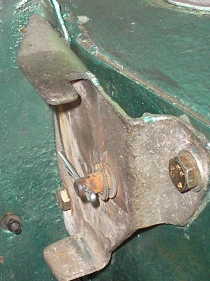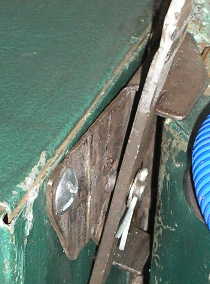
Series Land Rover
(U.S.A./Canada)
|
|
|
Series 3 Land Rover
Land Rover Series 1 quiz
Land Rover Series 2 quiz Land Rover Series 3 quiz 4x4 offroad quiz Problem you can't solve? Check the Tech Articles About Us Contact Us Disclaimer Humour Last Updated 6/1/16 |
We are all familiar with the need to work safely when carrying out repairs and maintenance on any vehicle. For the owner of a Series Land Rover, with the spare wheel stored on the bonnet, there is the additional risk of an ageing single weld being able to withstand the repeated stresses of supporting the bonnet and attached wheel. I get nervous having all that weight above my head. Even without items being stored inside the wheel, the weight amounts to around 33kg for a standard 7.50 x16 wheel and tyre.
This is the standard bonnet prop bracket as fitted to the LHS of Series Land Rovers. Notice the vertical step in the bracket which is required for making contact with the sloping side of the inner wing.
The above photo shows the same style bracket with the prop rod fitted and held in situ by a split pin. The RHS wing does not slope. The vertical step has been flattened and screwed into the RHS inner wing. The bottom horizontal step, seen below the split pin, which just acts as a rest stop for the prop rod when the bonnet has been raised, has been bent through 180degrees. Heat is required for flattening the vertical step due to the thickness of the metal and to avoid fatigueing it. Heat treatment is essential for reversing the horiziontal step throgh the 180degrees, unless you are going to cut it off and weld it back 180degrees to its original position. The prop bracket is bolted through the inner wing in three places and it is not at all easy to jiggle two of those bolts into position - hidden in the photo above. It may be achieved by using wire to locate the bolts into the holes. A much easier solution would be to use rivnuts if available, or weld captive nuts onto the bracket. Also, note the use of a roundheaded bolt as the third bracket fixing; this is to allow the bonnet prop to pass over it more easily, whereas a normal headed bolt would cause an obstruction. The original top mounting bracket for the bonnet prop is welded to the steel frame of the bonnet and the prop bolts into this. So there is a choice of either making and welding a similar bracket to the original for the top of the prop fixing (it's not available as a separate Series Land Rover part) or making a bespoke bolt-on bracket as illustrated below.
Again, rivnuts would be a blessing but the above example is fixed with two rivets and the nuts for the two bolts were jiggled into position behind holes drilled for them and by uilizing an existing and very convenient access hole.
|
|
Hitch a Series ride
![]() Back
to top
Back
to top



